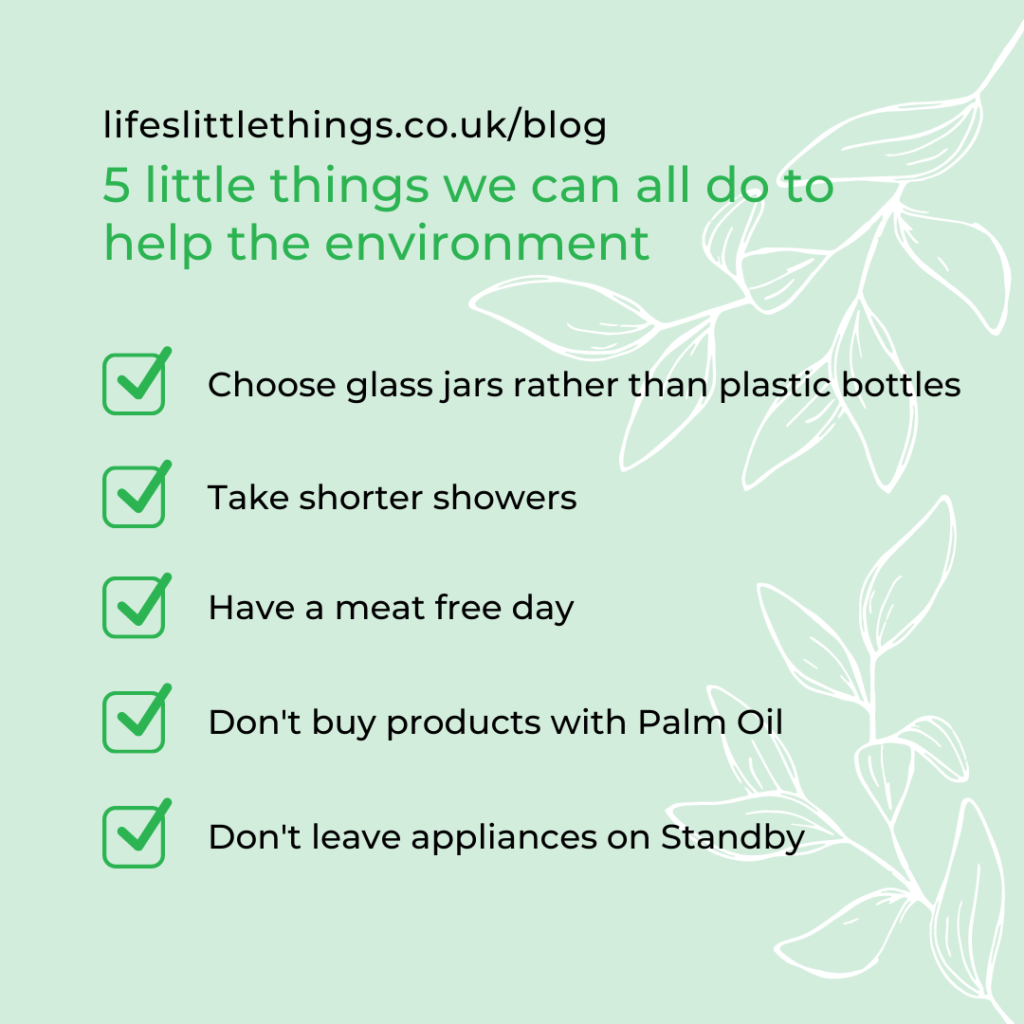The state of the environment and our planet is something I have become very concerned about since becoming a Mum. This is something I want to try and do something about through Life’s Little Things. (See my previous post, A little bit about Me, to find out why.) I have always tried to recycle and never litter, but I want to do much more to help.
Over the past few years I have seen documentaries on the state of our planet and sometimes am left feeling like it is an impossible task to try and fix. So I did my usual trick when things feel to big for me to handle, I took a step back and broke it down into more manageable tasks. So…. here is my list of 5 little things we can all do to help the environment. By choosing 5 little things to do to help the environment, I’m hoping they’ll integrate into our everyday lives easily. Then when they become natural to us, we can choose some more changes to make.

Carbon Footprint?
In this post I am going to be mentioning the words ‘carbon footprint’ a lot. So I just wanted to give a little more information about what your carbon footprint is. A persons carbon footprint is based upon the amount of greenhouse gases that are created depending on their actions and their lifestyle. Green house gases damage the environment and are a contributing factor to climate change. So the lower your carbon footprint, the better it is for the environment. Many of my points below help to reduce your carbon footprint. Woohoo!
1. Choose glass jars rather than plastic bottles
In Supermarkets, when you buys things like mayonnaise and ketchup, you can either buy them in glass jars or plastic squeeze bottles. Straight away I thought plastic was the worst of the 2 options. However, after doing some research into this, I found that there are actually pros and cons for both with regards to the environment when considering which to buy.
In many ways plastic is the worst of the 2 options. It becomes a huge problem when it ends up in landfill sites as it takes so long to breakdown. Or if it ends up in our Oceans and biodegrades, it breaks down into micro plastics that fish eat and plastic ends up in the food chain. However, I found that if plastic is recycled properly it does have a much much lower impact on the environment.
Glass initially seemed an obvious better option. It can be very easily recycled or cleaned up and reused for many purposes at home. Another bonus is that it doesn’t contain the same chemicals that plastics do. However, the production of glass carries a higher carbon footprint than plastic due to the processes used to create it. This in turn creates more greenhouse gasses that causes more damage to the environment.
So it turned out that it wasn’t a totally simple answer to just choose between the 2! For me, even though it has a higher carbon footprint, I think that glass is the better option when considering how harmful plastic is to the environment. I’m going to do other things to help reduce my carbon footprint instead to help offset the amount used to create glass. Something else I found out when comparing glass bottles to their same brand plastic squeeze bottle equivalents, the glass jars more often than not are cheaper and you get more content for your money! Bonus!
2. Take shorter showers
I am guilty of taking a longer shower than I should every day. Long showers do not only use up a lot of water, the energy used to heat the water creates higher Co2 emissions which increases your carbon footprint. The recommended time to spend in the shower is 5 minutes. Another recommendation is to turn the water temperature down. Not only will these 2 things save water and energy, it will also save you money! Win win! Maybe you could set a timer, like an egg timer, to help you stick to a 5 minute shower.
3. Have a meat free day
I’ve heard we should reduce our meat intake to help the environment but I didn’t know why that would help. So I did some research to find out more. A lot of land, water and energy resources all go into the production of livestock for the consumption of meat. All these things have an impact on the planet. The amount of animals needed to meet consumer demands also creates a lot greenhouse gasses. The more greenhouse gases that are created, the more damage is done to the environment.
An article I found on the internet about reducing our meat intake had a line that really put it into perspective for me, ‘the emissions associated with producing one quarter pound of beef is about the equivalent of driving a car for 7 miles!’* I found that shocking! I’m not saying we all have to turn vegetarian or vegan! But by reducing our meat intake by maybe having a meat free Monday or replacing some of our meat with plant based options, we will reduce the demand for so much harmful meat production and will reduce our carbon footprint at the same time. We’re going to start doing a meat free day once a week to start with and see how we get on!
4. Don’t buy products with palm oil
This is something that I want to write a longer blog post about in the future. It is quite a big subject, but here is a little bit about it. After watching the David Attenborough documentary ‘Extinction: The Facts’ (still available on BBC iPlayer if you want to check it out!) I was shocked to find how damaging the production of palm oil is to rainforests, animals homes and it is endangering species. Every hour, the size of 300 football fields of rainforests are being destroyed due to the demand for palm oil. That is insane! As soon as I heard this I decided that I wanted to stop buying products that contain palm oil.
I had heard that peanut butter was a product that contains palm oil and was really pleased when I found a substitute for it. But I was so disheartened while unpacking the rest of my shopping to see how many other products I had bought contain palm oil! A lot of big brands use it. A lot! Finding replacements for every product that uses it in my house in one go would be a huge task. So, I am going to focus on finding replacements one at a time. When looking at the products packaging, palm oil can be listed under several different names, so you need to keep an eye out. (View the Ingredients list in this article on WWF to see what other names Palm oil may be listed as.)
Some companies say that they use organic palm oil or sustainable palm oil within their products. These are better options, but to really reduce the demand for it, it is best to try and find a replacement with no palm oil in at all. By doing this you might have to spend a bit more money on products but you will be really helping the environment!!!
5. Don’t leave appliances on standby
A really easy thing that we all can do to help the environment and will help us all save some money too is to switch things off of standby. This increases your carbon footprint without you even knowing it. Although most appliances sold now have standby modes that use very small amounts of energy, the absolute best thing to do to make sure no energy is being wasted at all is to switch things off at the wall plug when they are not in use. I am going to start doing this more at home by making sure things like the tv and the baby monitors are all switched off at the wall when they are not in use.
So that’s it, 5 little things we can all do to help the environment!
Hopefully the tips have been helpful. They are only little things to do to help the environment, but if everyone did them they could make a big difference. My family and I will be doing all of them. I will do some more posts over the coming months on how we can all help out our planet more. After all, it’s the only one we have got! See you in 2 weeks, but check out my Facebook and Instagram accounts for more regular posts!
Take care,
Jem X
*statistic from mondaycampaigns.org which originally came from Pelletier, N., Pirog, R., Rasmussen, R. (2010) Comparative life cycle environmental impacts of three beef production strategies in the Upper Midwestern United States. Energy Use Agricultural Systems; Volume 103, Issue 6, July 2010, Pages 380-389.

